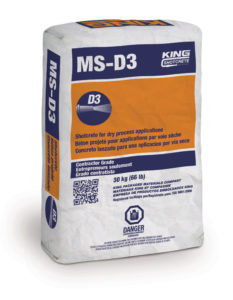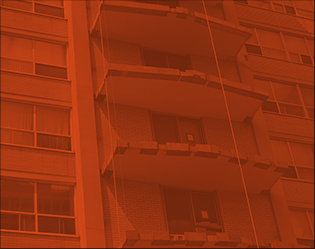Shotcrete as a Long-Term Solution to Power Canal Wall Stabilization
MS-D3 X
• Improved performance in cold temperatures.
• Improved performance in presence of running water.
• Allows for earlier re-opening of traffic lanes on bridges and in subway tunnels.
Located in central Ontario’s cottage country and founded in 1914, the Peterborough
Utilities Commission (PUC) operates as a not-for-profit organization providing safe and
reliable supplies of electricity and water to the city of Peterborough, ON, Canada. Restructuring
in 2000 led to the PUC becoming part of the Peterborough Utilities Group, and it continues to
operate as such.
In April 2008, PUC, in partnership with Trent Rapids Power Corporation (TRPC), began
construction of The Robert G. Lake Generating Station, an 8.0 MW run-of-the-river hydroelectric generating facility on the Otonabee River. The powerhouse and southern portion of the power canal were to be situated within the city of Peterborough on land leased from Trent University. The intake structure and northern portion of the power canal were to be located within the nearby township of Smith-Ennisclaire-Lakefield.
The project included the following key features:
• An intake structure located adjacent to the west end of the Lock 23 Dam and Lock 22 Dam;
• A 3445 ft (1050 m) long power canal on the west bank of the river between the Lock 23
Dam and Lock 22 Dam;
• A powerhouse containing two 4.0 MW turbines; and
• A 44 kV substation and power line injecting energy into the local distribution grid of
Peterborough Distribution Inc.
The initial power canal design called for the excavation of near vertical walls into the bedrock.
During excavation, TRPC made some observations that differed from what was expected on site. The two most critical observations were inconsistencies in the elevation of the bedrock and unexpectedly poor bedrock quality. These observations led the team at TRPC to enlist the services of a Mississauga, ON, Canada-based consulting firm specializing in excavation shoring, underpinning, and foundations design.
The design engineer’s initial scope was to inspect the rock quality and provide a design that would provide erosion protection of the canal banks and prolong the usable life of the canal. The results of the rock quality evaluation indicated three distinct classifications of bedrock. These classifications were categorized as:
• Rubbly limestone—a loose mass of rough, angular fragments of limestone, influenced by
plant life and hydrological effects;
• Limestone with clay—interbedded limestone and clay with less decomposition than the
rubbly unit; and
• Limestone—a consolidated unit.
Subsequent to the rock evaluation, design engineers submitted four optional approaches to
address the issues related to poor rock quality. Each option was dependent on the amount of
available space along the edge of the canal. The slopes that were initially specified would lead to
excavation encroachment onto neighboring private property.
The first option involved initial excavation to sound rock, after which the slope would be cut
back to 1.5H to 1V, followed by the installation of rip rap. The second option was to install a
precast retaining wall, cut back the slope to 1.5H to 1V, and install rip rap. The third option (Fig. 1) was to excavate the overburden, install rock anchors and mesh, and apply shotcrete to the weathered rock. The fourth option (Fig. 2) was to install anchors and mesh and apply shotcrete to the full height of the canal.
Option 1 was selected in areas where there was enough room on the property to cut the appropriate slope and was limited to some areas along the east bank of the power canal. Option 2 was selected along the west wall, where there were limited options due to the location of the existing dyke. Rip rap was used in conjunction with this option to protect the slope of the dyke. Option 3 was selected for some areas where more space was available, but multiple designs were used to fit the allowable property space. Rock anchors, mesh, and shotcrete were used to cover the remaining unstable rock surface. Option 4 was the only feasible option for the area along the west wall of the canal, where there was minimal available land between the power canal and the river (Fig. 3). With this option, the entire rock surface had to be covered with shotcrete to prevent future erosion.
In the spring of 2008, a contract for the construction of The Robert G. Lake Generating Station was awarded to a company from Lévis, QC, Canada, and the shotcrete portion of the contract was then subcontracted to a Quebec City company. After they were awarded the contract to apply the shotcrete, subcontractor representatives met on site with the general contractor, design engineer representatives, and materials supplier technical staff to confirm their recommendations related to application logistics, shotcrete mixture design, and scheduling. The subcontractor preferred the option of dry-mix shotcrete, primarily because of the difficult access and rough terrain along the banks of the canal. The flexibility offered by preblended, bulk-bag materials also allowed the shotcrete crew to carry an inventory of shotcrete material on site (Fig. 4). Access to the materials improved the subcontractor’s ability to schedule shotcrete application and also allowed them to start and stop when and where required without equipment cleanup and wasted shotcrete material.
The specified shotcrete mixture was a silicafume-enhanced, air-entrained dry-mix shotcrete
and was used throughout most of the project, except in areas where moving water required the
use of an accelerated mixture. The shotcrete was applied at a specified thickness of 4 in. (100 mm).
Prior to the application of shotcrete, rock anchors were installed in a staggered vertical 5 ft (1.5 m) by horizontal 5 ft (1.5 m) pattern (Fig. 5). The anchor lengths were 5 ft and 12 ft (1.5 and
3.6 m), depending on the quality of the rock. Welded-wire mesh (5 x 5 ft [1.5 x 1.5 m]) was
then attached to the anchors. Installation of the mesh served two purposes: first, to improve the energy absorption of the shotcrete; and second, to improve the adhesion of the shotcrete to the poorer quality, fragmented rock.
An ACI-certified nozzleman was part of the shotcrete crew, as specified by the design
engineers (Fig. 6). They used a dry-mix shotcrete machine to place over 32,000 ft2 (3000 m2) of
shotcrete throughout the canal. The subcontractor chose a shotcrete machine that featured rugged construction and high-volume output (up to 10 yd3 [8 m3] per hour).
Through the use of shotcrete, the engineer’s design achieved the objective to provide erosion protection of the canal banks and prolong the usable life of the canal. The project was completed in December 2009 and will be expected to produce and annually inject approximately 30,000 MWh into the local electrical Distribution system of Peterborough Distribution Inc.
The Robert G. Lake Generating Station has a renewable energy contract with the Ontario Power Authority (OPA) for a 40-year term. This green energy project will provide the electricity needs of approximately 3000 homes and annually offset 20,000 to 30,000 tons (18,144 to 27,216 metric tons) of carbon dioxide.







